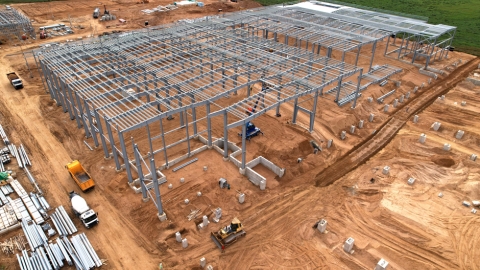Construction projects vary in scale. Some are small, precise operations, while others are large and complicated with many moving parts taking place over a sizable area.
While construction project managers will tell you that control of the project in real time is one of their top priorities, it’s also one of their biggest challenges, since control in real time requires data in real time.
Imagine a huge lot on which a hospital is being built. To track the project, a surveyor will have to walk the entirety of the lot, taking photographs and notes as they go. By the time they finish, they’ll have to start again to ensure their data is fresh and reflects the actual conditions of the project as it currently stands.
This process is slow and reactive, leaving project managers constantly playing catchup as they discover new issues that may have surfaced since the last full-site inspection.
Compare this approach to using a drone for the same purpose.
A drone can fly a large construction site in 15 minutes, collecting video footage of it the entire time.
That footage can then be processed into a useful report showing you exactly where potential opportunities for improvement might be. It can also be used to make an orthomosaic map of the lot—a high-quality image of the entire property made by stitching several images together—or a detailed 3D model.
And site surveys are just one of the many ways drones are being used in construction today.
Here’s a list of all of the ways construction companies are employing drones in their work:
1. Verification
Drone data can help ensure work is complete and materials have been delivered.
2. Improved Project Oversight
Improved project oversight. Drone data helps project managers keep their eyes on multiple projects, allowing them to stay on schedule and avoid rework, delays, and missed deadlines.
3. Data Validation
Data validation. Project managers are using drone data to create stockpile volume measurements to track the amount of material on site, or the amount of earth that has been moved, as well as to confirm elevations for site grading or cut/fill analysis.
4. Documentation
Documentation. Drone data provides a thorough record of the project, which can be useful as a backup for case-building in the event of failure, defects, missed deadlines, or insurance claims.
5. Keeping the Site Safe
Keeping the site safe. Visual insights from drone data can quickly reveal where dangerous areas may be on-site, helping make determinations about which areas should be cordoned off to protect personnel and people who may happen to wander into the construction zone.
6. Closeup Inspections
Closeup inspections. A drone equipped with a zoom camera or a high-megapixel camera can capture up-close visual data reflecting the status of a building’s facade, showing the deterioration of materials, or reflecting the failure of building components, helping to quantify the presence of defects or distress in parts of a project for making rework determinations.
Want to start using drones in your construction work? DroneUp can help.
We have a team of expert drone pilots with thousands of hours in the field who are ready to help you get the data they need.
Learn more about the drone-related construction services that DroneUp provides now.
